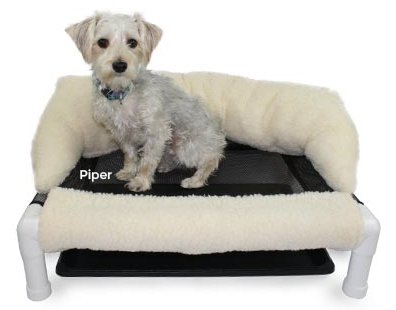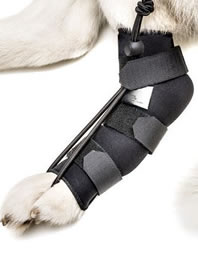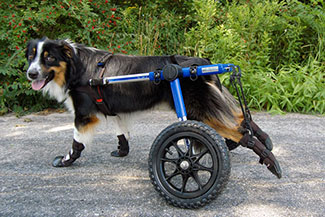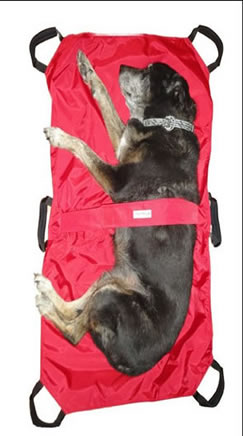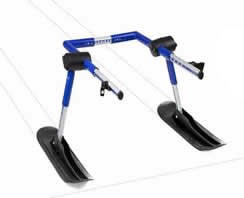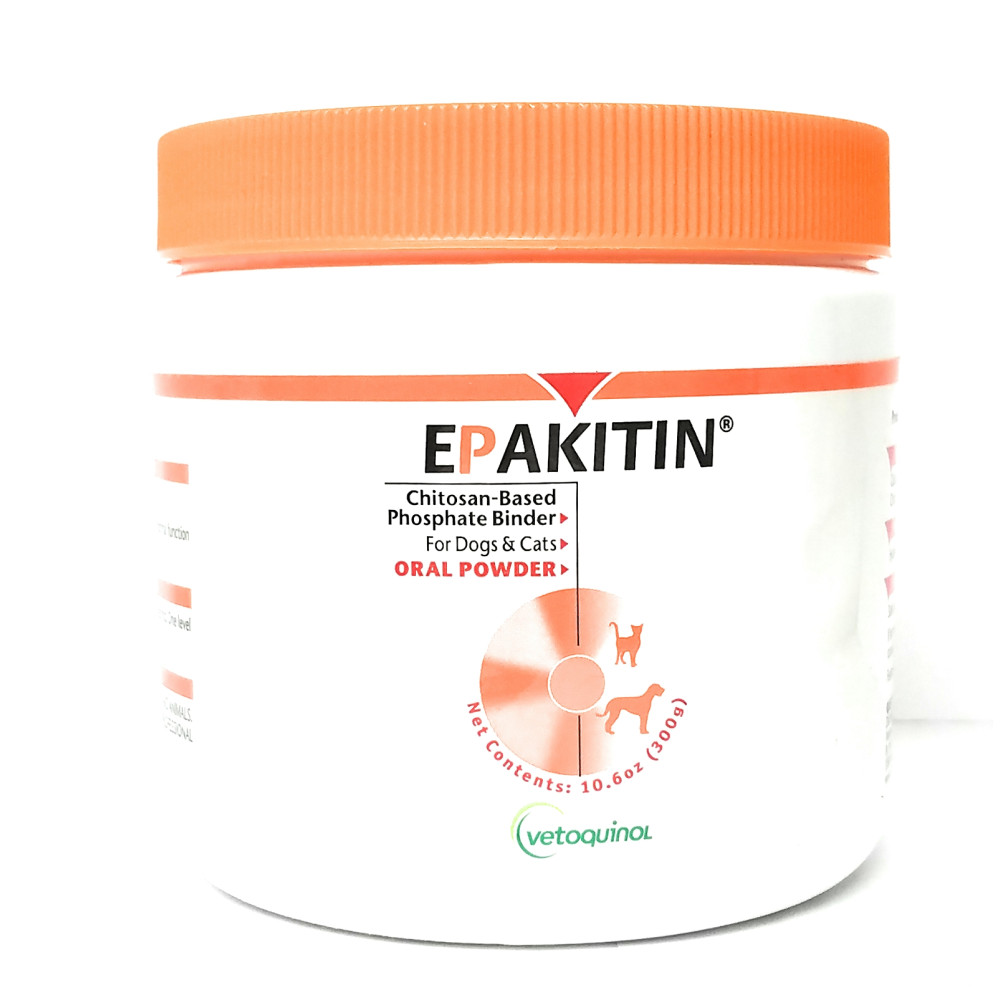Degenerative Myleopathy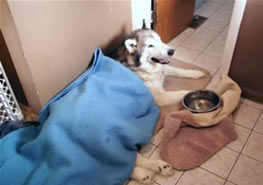
Degenerative Myelopathy is a progressive disease involving the spinal cord. It is thought to be an autoimmune disease. It appears with relative frequency in German Shepherd Dogs, and though Malamutes are thought to be largely unaffected, we've had several males come down with this disease. While I've heard of MANY Malamutes having rear-end weakness, hip dysplasia, arthritis, it's not all that common to hear of dengenerative myelopathy in Mals. Why this is, I'm not sure, perhaps because it affects them at an advanced age, it is not being diagnosed properly or the dog is put down because of the difficulty involved when a large active dog becomes immoble.
DM presents itself with waxing and waning of the following symptoms:
- hindquarter weakness
- rear limb ataxia (reflex to right foot when turned backwards, slow, or non existent)
- loss of balance
- difficulty rising or laying down
- knuckling under while walking
- limp tail
- rear legs crossing under body
- rear leg drag
- spinal ataxia
- hoarseness of bark
leading to paralysis, and incontinence in the final stages...but it comes on slowly.
If any of these symptoms come on SUDDENLY, you are, in all probability, NOT dealing with Degenerative Myelopathy, but rather, something else. DM is slow, insidious, and your first time noticing it you will probably think your dog just lost his balance or tripped. There are many conditions which can easily be confused with DM. However, DM does not appear with a SUDDEN onset, but is rather a slow, almost imperceptible process of deterioration. If your dog has suddenly developed the symptoms described above, please make sure your vet looks for other problems involving the hips or spine! DM is NOT a disease that comes on suddenly!
There are two people studying this disease intensely. Dr Clemmons who is associated with the University of Florida has been studying DM for many years. He feels that DM is related to MS in humans. He invented the Flash test for DM, generally considered more accurate for German Shepherds, which most of his research has been done with. Dr Coates is with the Univ of Misssori, and is more recent in the field. She believes DM is related to ALS in humans. She invented the DNA test for DM. The DNA test can identify the genes that are responsible for DM, but just because your dog has the gene, it does not mean he will get DM. It just means he has the possibility of getting DM. However, if he doesn't even have the genes for it, he most likely doesn't have it. She has not created any medical protocol for treatment.
One of the first symptoms we've noticed in our older dogs that have come down with this is the hoarse bark. This then seems to progress to loss of balance or difficulty rising or lying down. Often the dog walks just fine once he's up...it's getting up that is the problem. While every article I've read says it's mainly in German Shepherds - it's important to note that during the Gold Rush Malamutes were bred to all sorts of breeds in the Yukon - including German Shepherds. Also, German Shepherds have been studied the most extensively, as they seem most affected. In malamutes, this may be a genetic anomaly leftover from the crossbreeding that was done years ago in Alaska.
There is no cure for Degenerative Myelopathy, although there are programs which can possibly slow the progression of the disease. Onset of DM can be between 5-14 years of age, but has shown up as early as 3 yrs of age. When our dogs have gotten it, (3) it's always been at an advanced age - 11 or later. Usually, the progression of the disease is slow and gradual in the early stages, and can sometimes be mistaken for hip displaysia or arthritis. In the latter stage of the disease, progression is more rapid. In our experience it can take anywhere from 1 - 4 years for the dog to become paralyzed in the rear. Vets are often too ready to "write off" DM dogs, telling the owner that nothing can be done to help their Malamutes, other than trying to make them comfortable. Too often, vets do not inform their clients of the program to help slow the progression of DM, and many are completely unaware of the existence of Dr. Clemmon's program which I just discovered. That said, in general it is still limited what can be done beyond vitamins, exercise and keeping the dog in general good health.
Diagnosis is made by a history of progressive weakness in the rear that comes and goes. This is supported by the neurological findings of a diffuse thoracolumbar spinal cord dysfunction. Generally this cannot be diagnosed by your regular vet because examinations are generally normal except for an elevated cerebral spinal fluid (CSF) protein in the lumbar cistern - which they are not likely to check. Most vets will do an X-ray, blood tests, and a physical exam which will show nothing. I went though this for years with Hoover - almost yearly I knew something was wrong, not knowing what. I'd have the vet run blood tests and a general exam and he would come back in perfect health. I would go away perplexed knowing something wasn't right, but having no proof would wait until symptoms appeared again and would try again - only to be told everything was find - AGAIN. Technically, Electromyographic (EMG) examination reveals no lower motor dysfunction, which supports the theory that the disease is localized in the white matter pathways of the spinal cord. Spinal cord evoked potentials recorded during the EMG do show changes which help determine the presence of spinal cord disease. Radiographs of the spinal column including Myelopathy are normal (other than old age changes) in most cases of DM. All dogs we've had xrayed bear this out.
Dogs afflicted with DM develop depressed lymphocyte blastogenesis to plant mitogens. The depression of their cell mediated immune responses correlates with the clinical stage and severity of the disease. Furthermore, this suppression has been shown to be due to the genesis of a circulating suppressor cell. Some dogs with DM exhibit antigen-binding cells specific to canine myelin basic protein. Immunoglobulins have been shown to be bound within lesions within the spinal cords of dogs with DM. These dogs also show increased circulating immune-complexes in their sera. The antigens in these immune-complexes have been examined and appear to be markers of inflammation as they have been found to exist in dogs who have other inflammatory diseases of the central nervous system. What this basically means is they are having an allergic reaction to their own cells, causing irritation and inflammation to the sheath covering the spine and other nerves.
Recent findings show that CSF levels of the enzyme, acetylcholinesterase, are elevated in dogs with DM. This also occurs in other forms of central nervous system inflammation in dogs so you must consider history, neurologic signs, CSF protein concentration and EMG, an elevated CSF acetylcholinesterase levels confirm the diagnosis.
Myelograms do not rule in DM - they rule out surgical disease. Before a myelogram is done, an Electromyogram should be done first. EMG results can differentiate between peripheral nerve disease, inter-vertebral disc disease and myelitis and polyradiculoneuropathy. First rule out the presence of surgical disease (DM is one of the non-surgical diseases). It can be better to start testing for DM with the least invasive tests, leaving the more serious tests for last.
One of the most obvious features of DM is the weak muscles of the rear limbs. Put under a microscope, the muscle tissue has lesions consistent with widespread demyelination of the spinal cord - in other words, the cover of the spinal cord is deteriorating and looks like swiss cheese. Most of these lesions are in the lower back. In severely involved areas, there is also a reduced number of axons, an increased number of astroglial cells and an increased density of small vascular elements which indicate nerve damage. Similar lesions are occasionally seen scattered throughout the white matter of the brains from some dogs, as well. Some dogs have plasma cells with holes in the kidneys and throughout the gastrointestinal tract, providing a hint to the underlying immune disorder causing DM.
The University of Florida has been at the forefront in studying this disease. They have have provided important new insights into the pathoetiology of DM. The release of antigens during the disease process could explain the immune deficits seen in DM and suggests that processing these immune-complexes by circulating macrophages leads to the development of the circulating suppressor cells that were previously noted. This also explains the presence of immune abnormalities in dogs with DM. Proteins that are present create inflammation which irritates the nervous system. Currently, there is no one test that can diagnose this disease. Treatment of DM has currently only been studied in German Shepherd dogs. It is hoped that research involving the antigens present in the immune complexes formed in degenerative myelopathy will lead to a blood test for this condition.
While the cause of the altered immune system is not known, my suspicion is that it is genetic. Unfortunately, it's not easy to breed out or away from. It only becomes apparent in old age after the dog has already been bred. I also suspect some type of X chromosome inheritance since none of our girls have ever been affected, just males. DM has also been compared to Multiple Sclerosis in human beings. In fact, based on new research data, they are now saying that they are pretty sure it IS MS in dogs. As yet, there is no known triggering factor that cause the immune-complexes to circulate. These immune-complexes lead to endothelial cell damage in the vessels. Subsequently, fibrin is deposited in the perivascular spaces. When this degrades the neurological cell linings with a kind of acid, inflammatory cells are stimulated to migrate into the lesions. The inflammatory cells release prostaglandins and cytokines which leads to the activation of tissue enzymes and the formation of oxygen free-radicals which, in turn, leads to tissue damage.
Diagnosis
A diagnosis of degenerative myelopathy is based on a history of progressive spinal ataxia and weakness that may be waxing or steadily progressive. The diagnosis is supported by neurological findings of widespread back spinal cord dysfunction. Laboratory findings are generally within normal limits except for an elevated cerebral spinal fluid (CSF) protein. A myelogram (contrast dye study of the spine) must be performed to differentiate degenerative myelopathy from disc disease, tumors, and other progressive neurologic diseases.
Treatment
Do not wait until the dog goes down to have the appropriate equipment on hand for dealing with what is inevitable. You may eventually need alift support sling or wheelchair to assist the dog to walk or get up.
Our instincts tell us to try to protect the dog’s feet from bleeding, due to knuckling. However, booties on the feet are NOT a good idea. Booties interfere with foot placement and the conduction of nerve impulses. If you place booties upon a DM dog's feet, you can actually do more harm than good. The only time this would be ok is if the dog is using a wheelchair and the feet want to drag - then they need to be supported.. A DM dog that is still walking upright, with booties, is apt to fall more often suffering consequences such as cruciate ligament tears, knee injuries, disk injuries and further spinal damage. You are better walking the dog on grassy surfaces while using a rear end harness, which will allow you to lift the hindquarters into a position for correct foot placement. The rear harness or the knuckle under sock are some of the items people have found to be extremely helpful. You can also make your own with a towel and some webbing. Carts and wheelchairs can be successfully used outdoors, and sometimes indoors but do not usually allow the dog to sit or lie down so cannot be used constantly. .
Never hold or attempt to hold a DM dog up by its tail!!! To do so, can cause great harm to a DM dog!! Holding a DM dog up, supporting it, or lifting it by the tail can break the tail and cause further damage. DM is a terribly destructive disease without making things worse. Should a vet suggests this as a method of transporting your DM dog don't listen! Ideally a transport stretcher is a great way to move a mobility impaired dog
There are good vets and there are bad vets. There are, unfortunately, too many vets who are completely ignorant when it comes to DM! Even some of our best vets have looked at us blankly when we told them a dog we have has DM. One even insisted we "bring him in" for a simple ear infection rather than just prescribe medicine we both knew would work. So I made a stretcher, and it took two of us to bring Hoover into the vet office to be seen. Not that he didn't enjoy it - he had a rare and fun outing with lots of attention - but it was also totally unnecessary. Rear end harnesses were created for the purpose of lifting a DM dog safely! They enable you to lift the hindquarters without harming the spine, the disks or the tail.
If your dog is exhibiting pain, it probably isn’t DM, unless there is a concurrent condition. DM is not painful. There is zero pain because the nerve cells have died. So ignore people who tell you you are being selfish keeping a DM dog around - if he's enjoying life and you have the patience - go for it! He is in NO pain!!!
While there is no "cure", there are methods to hopefully slow the progression of the disease and keep the dog in the best condition so the disease progresses as slow as possible. Treatment of DM involves four basic approaches:
1) exercise
2) medication
3) vitamins and supplements
4) other supportive measures
Exercise:
Regular exercise above and beyond "playing in the yard" is important for the prevention of chronic degenerative diseases. In human studies they have proved that improved muscle performance, memory and cerebral blood flow helps dogs with these types of conditions Many of the goals of treatment in DM dogs are obtainable through regular exercise. Two forms of exercise seem the most useful: walking and swimming. A number of owners have reported that swimming is more helpful for dogs beyond walking. Swimming generally increases muscle tone and allows movement without stress on joints. Swimming is not always convenient or possible so walking with a wheelchair is another way to build strength, since gravity is involved and it allows the dog to do as much as he can to move around the yard. In older dogs, particularly those with arthritis, gradually building the exercise program is important. In addition, allowing a day of rest between heavy workouts can help the dog recover faster from the exercise.
Heartworm medication:
Since the monthly heartworm medications (Heartgard, Heartgard plus and Interceptor) increase immune responsiveness, we do not recommend using these products. Revolution, which is a new topical heartworm preventative, does not alter the immune response like the other monthly products. As such, Revolution should be safe to use in DM to control internal (and external) parasites.
Supportive Medications
The combination of aminocaproic acid, N-acetylcysteine, dietary supplements and exercise is the best treatment we have been able to discover to date. It corrects those aspects of the immune dysfunction which we can treat, based upon the belief that DM is an immune inflammatory disease. The chances of successful treatment are improved if the therapy is begun early in the course of DM rather than later. A response to the drugs should be evident within the first 7-10 days. There is no other medications that have been found to provide any real benefits in the long term treatment of DM. For your vet: further information about other treatments may be found in Current Therapy X, pages 830-833 and in Vet. Clin. Nor. Am. 22:965-971, 1992.
Vitamins:
B-Complex: B vitamins are water soluble and any excess amount will be eliminated through the urine. They may help in neural regeneration. In DM, there is altered absorption of some B vitamins and supplementation may help to correct this. If your dog is healthy, then give high potency B-complex (containing approximately 50 mg of most of the B components). If your dog has DM, give stress formula B-complex containing 100 mg of most of the B components.
Yeast: Nutritional yeast, in powder or flake form, is a good source of the B-complex vitamins, trace minerals, and some protein. A heaping tablespoon of yeast will color your dog's urine yellow (owing to its content of riboflavin). Sprinkling it on food, as an alternative to giving your dog a B-complex pill, is an option. However, it may be more difficult to be sure you are giving the right dose. Try 1-2 T with eat meal.
Antioxidants:
Vitamin E: Vitamin E is an important nutrient which has been shown to have a number of physiologic and pharmacologic effects. It is a potent antioxidant and reduces fat oxidation and increases the production of HDL cholesterol. At higher doses it also reduces cyclooxygenase and lipooxygenases activities, decreasing production of prostaglandins and leukotreines. As such, it is a potent anti-inflammatory drug. It will reduce platelet function and prolong the bleeding time slightly in healthy individuals. There is no known side-effects to vitamin E at levels less than 4000-6000 IU per day (except in cats, where levels >400 IU/day might create hepatolipidosis). This drug slows the progression of DM and corrects for low serum and tissue levels. In DM, there does appear to be a deficient absorption and tissue-binding protein which accounts for the low serum and tissue concentrations of vitamin E. For a Malamute over 2 years of age, that develops DM, then the dose of vitamin E should be increased to 2000 IU daily.
Vitamin C: Vitamin C works with vitamin E and helps regenerate vitamin E, potentiating its antioxidant effect. Vitamin C supplementation does no harm, since the excess is excreted through the kidney. While dogs produce vitamin C in their bodies (unlike human beings, pigs and guinea pigs who must have it in their diet), under stress or disease, they may need vitamin C in excess of their manufacturing capacity. In excessive dose, vitamin C can cause flatulence and diarrhea. This intestinal tolerance level varies among dogs, but is generally around 3000 mg per day in an adult Mal. Over 2 years of age, give 500 mg of vitamin C twice a day. If your dog develops DM, then increase the vitamin C to 1000 mg twice a day unless this level causes diarrhea.
Selenium: Selenium is an important mineral which has antioxidant properties similar to vitamin E. Vitamin E can replace the requirement for selenium in the body, but selenium cannot substitute for vitamin E. In addition, selenium does not cross the blood-brain barrier like vitamin E. On the other hand, selenium may help allow vitamin E to be more effective. Many plant sources are low in selenium and supplementation may be important. Selenium can create toxicity if given at too high a level; therefore, never give more that 200 µg of selenium per day in large dogs nor more than 100 µg per day to small dogs. Below these levels, selenium should be safe according to Dr. Commons. Give 200 µg of selenium daily.
Acupuncture:
The traditional Chinese art of insertion of needles into various specific points of the body (with injection of small amounts of fluid or electrical stimulation) has been shown to provide analgesia and relief from acute and chronic pain. This has the advantage of having none of the side-effects of analgesic drugs. In addition, acupuncture can do no harm. In DM, acupuncture alone slows the condition, but does not stop the progress. One the other hand, DM dogs who have concurrent arthritis may benefit from acupuncture therapy.
Prognosis
Degenerative myelopathy progresses at different rates in each individual. In our experience it came on some dogs faster than others - and some have a better tolerance for being immobile than others. Stress plays a role in its advancement. Minimizing stressful situations is important. An example is while one of our dogs has very mild symptoms, and you'd never really notice - if she gets excited she becomes very unstable and falls down. While anesthesia does not appear to cause problems with degenerative myelopathy, even minor invasive surgical procedures can result in a marked increase in symptoms, probably due to stress. Therefore, we recommend caution in considering major surgery in dogs with degenerative myelopathy. The worsening caused by surgical stress can be irreversible.
Resources
-
DM Yahoo Mailing list - go to your yahoo groups and join the Degenerative Myelopathy list (very supportive group)
-
AltVetMed IVAS Directory - for IVAS certified veterinary acupuncturists
Curriculum Vitae of Dr. Roger Mayeda Clemmons, DVM, Ph.D., Associate Professor of Neurology Neurosurgery at University of Florida. Dr. Clemmons is instrumental in the area of myelopathy research and related publications.
-
Answers from veterinarians to questions about degenerative spinal myelopathy.
-
DSM support email list is a place where all of us dealing with this dreaded disease are able to tell our stories and what has or has not worked for our dogs. Providing links to Dr. Clemmons, the major driving force in beating this disease, as well as other links to places that provide help and support. Email for information.
-
The Neurology Service at the University of Florida’s Veterinary Medical Teaching Hospital University of Florida presents , An Integrative Medical Approach to the Treatment and Control of Degenerative Myelopathy In German Shepherd Dogs. By R.M. Clemmons, DVM, PhD, Associate Professor of Neurology Neurosurgery, Department of Small Animal Clinical Sciences.
More information & Helpful links...
Carts and Assistance Supplies for Dogs:
- Walkin' Wheels Adjustable Wheelchairs for Dogs <--these are the best - my daughter's dog Cheesecake used one.
- Eddie's Wheels - wheel chairs for Malamutes (will rent depending on availability of carts)
- Dewey's Wheel Chairs for Dogs assists dogs with problems with their hind legs.
- Tail Wagon - wheels for dogs
- Dogs with Disabilities.com for elderly injured and handicapped dogs or cats - products services support to help you care for them.
- Canadian Animal Rehab Services - specializing in custom-made braces and animal wheelchairs for dogs and cats (custom help aids made with veterinarian oversight).
- K9 Cart Company features Malamute mobility aids for mobility-impaired Malamutes.
- OMS Medical Supplies, Inc. - magnet pads for your Malamute (you would want to order the "slim mattress pad", Bio-North side labeled as that is the side that would go against the dogs body)
- Diapers for male dogs
- Kennel Komforts Fabric - dog products (Belly Bands for incontinent dogs)
- Hartman's Hip Helper - rear-end harness
- DogLeggs - effective in treatment of elbow hygroma, arthritis, ulcers and calluses
- Soft Claws for dogs: helps prevent bleeding nail quicks
- Help Me Up harness A harness that can be left on, with hip lift.



